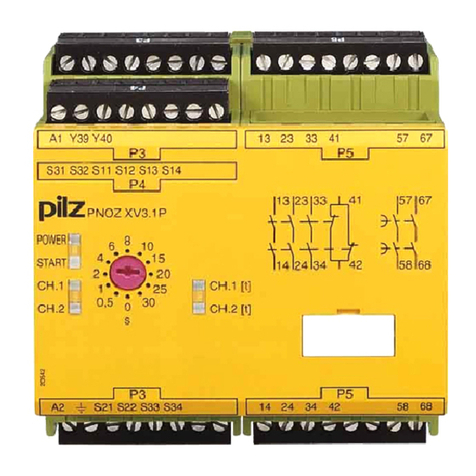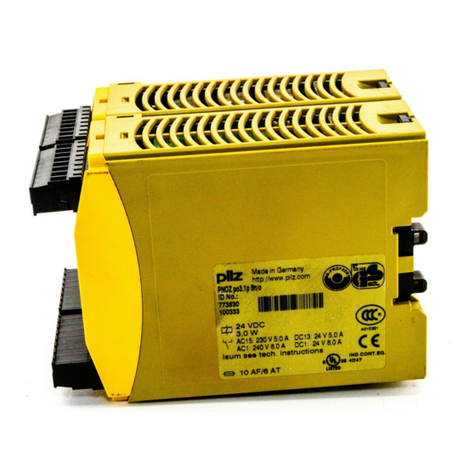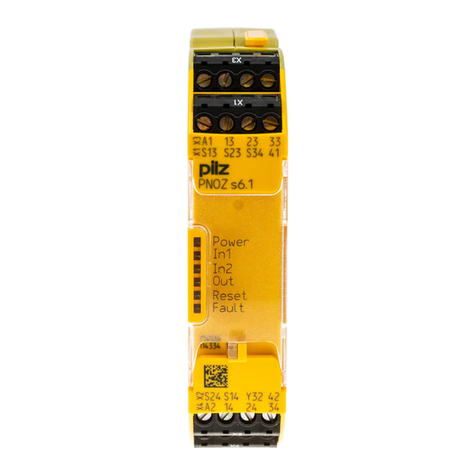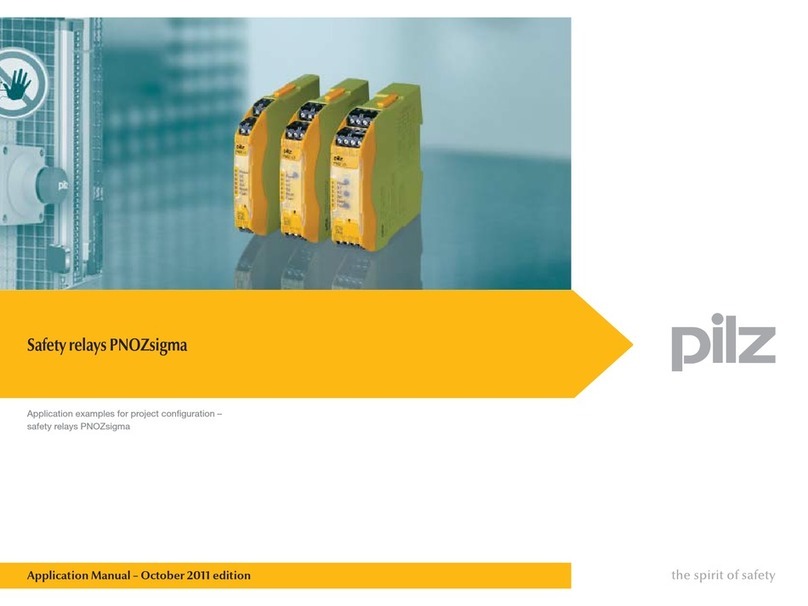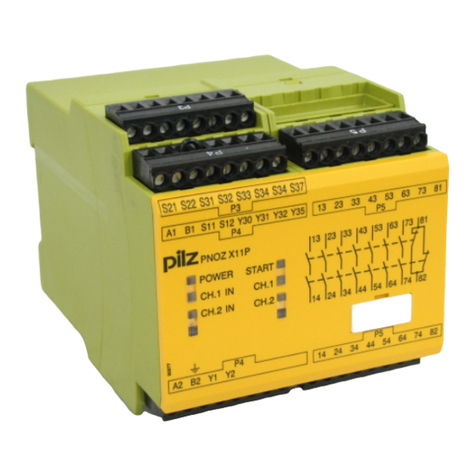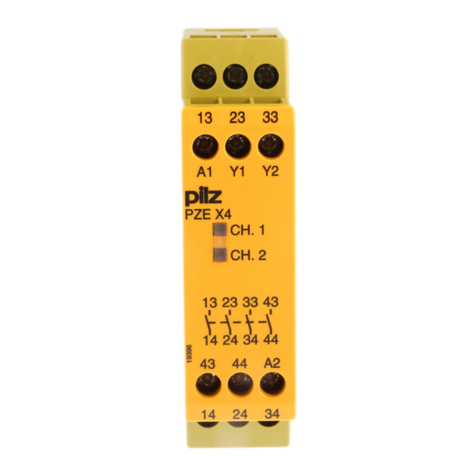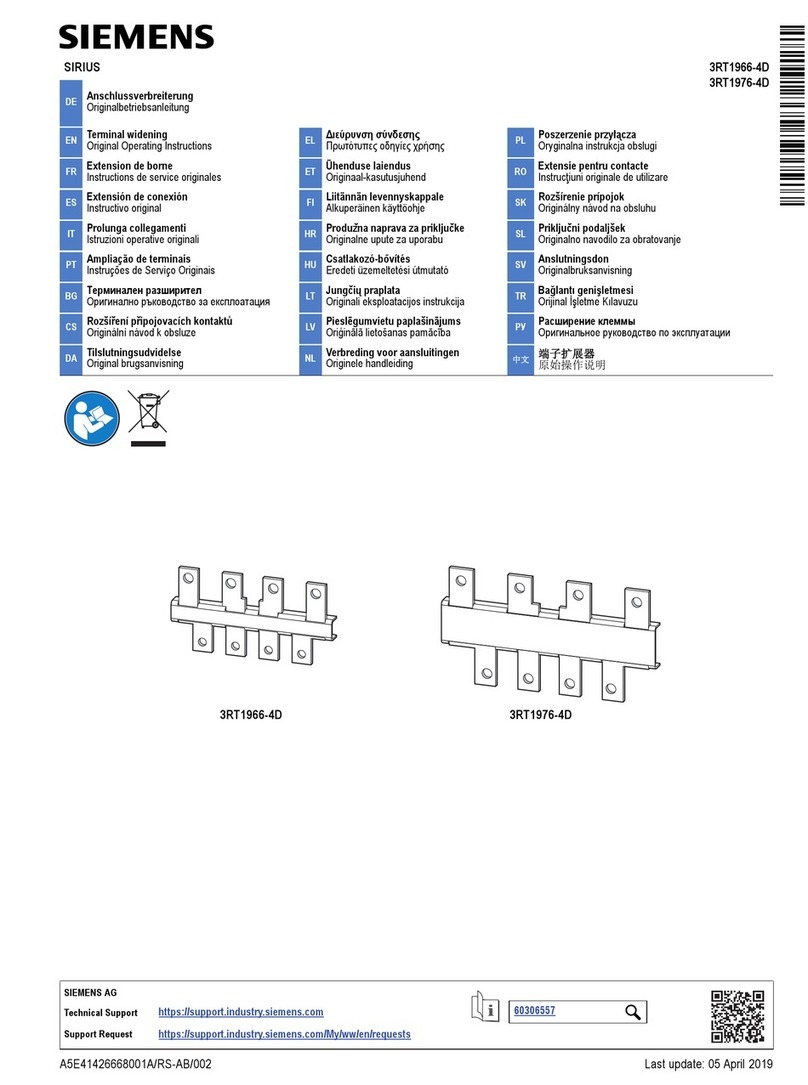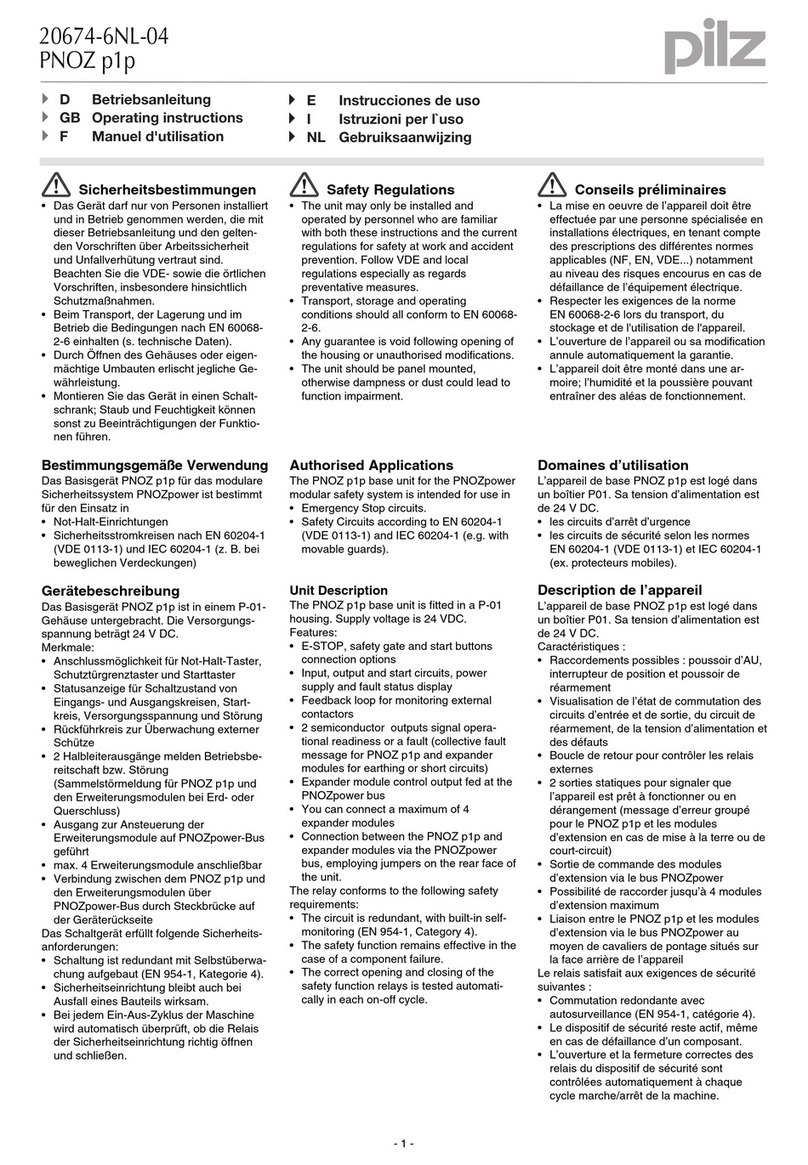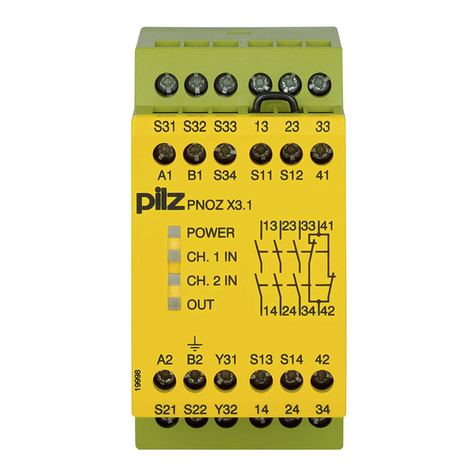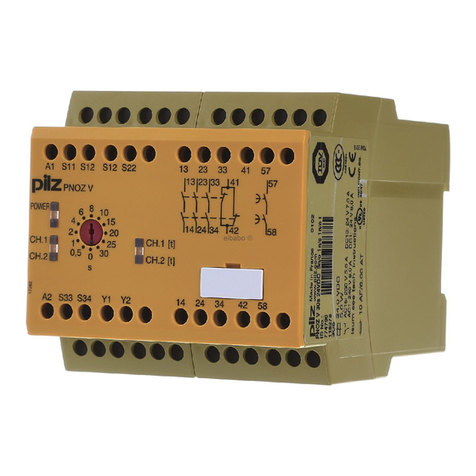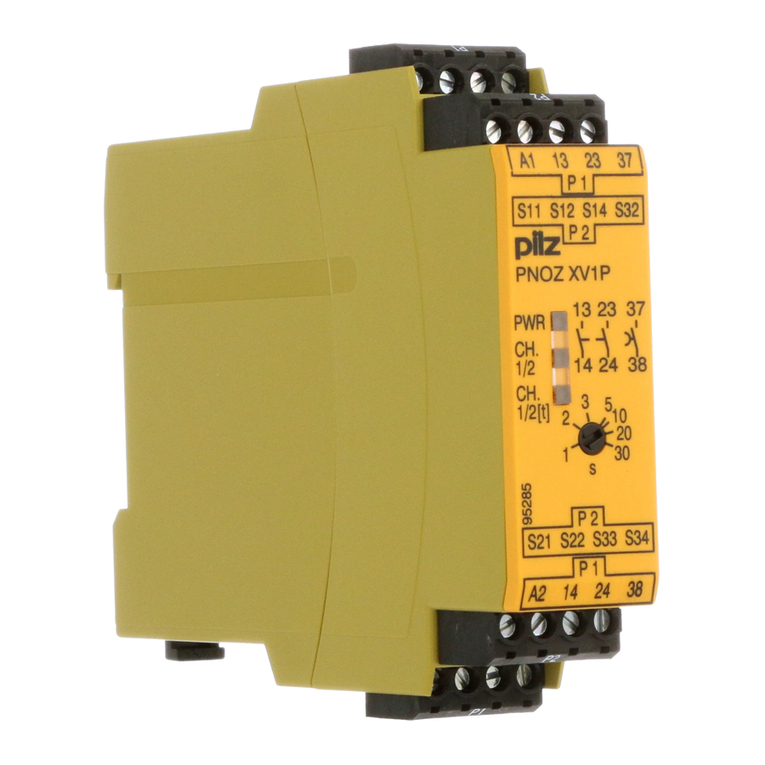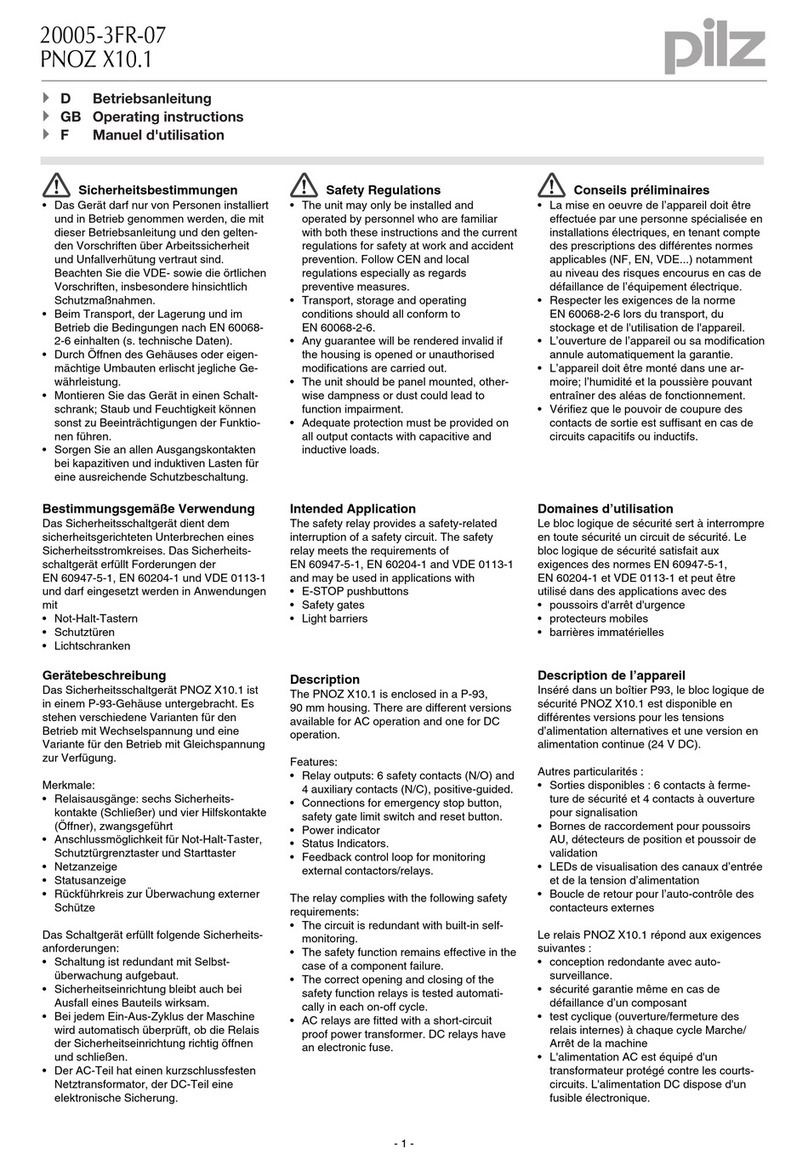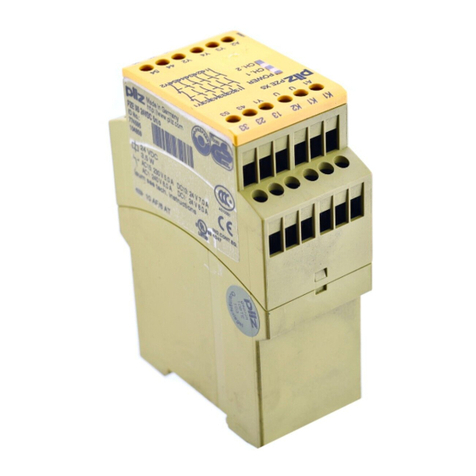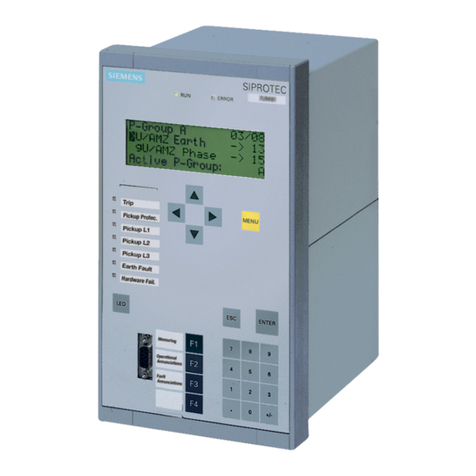
- 3 -
Statusanzeige:
• LED "ch.1" leuchtet, wenn Relais K1
angezogen hat.
• LED "ch.2" leuchtet, wenn Relais K2
angezogen hat.
• LED "ch.1 - t1" leuchtet, wenn Relais K4
angezogen hat.
• LED "ch.1 - t2" leuchtet, wenn Relais K5
angezogen hat.
• LED "ch.2 - t1" leuchtet, wenn Relais K6
angezogen hat.
• LED "ch.2 - t2" leuchtet, wenn Relais K7
angezogen hat.
Betriebsarten:
• Einkanaliger Betrieb:
Eingangsbeschaltung nach VDE 0113 und
EN 60204, keine Redundanz im Eingangs-
kreis. Erdschlüsse im Tasterkreis werden
erkannt.
• Zweikanaliger Betrieb ohne Querschluss-
erkennung: Redundanter Eingangskreis,
Kurzschlüsse und Erdschlüsse im
Tasterkreis werden erkannt.
• Zweikanaliger Betrieb mit Querschluss-
erkennung: Redundanter Eingangskreis,
Kurzschlüsse und Erdschlüsse im
Tasterkreis und Querschlüsse zwischen
den Tasterkontakten werden erkannt.
• Automatischer Start: Gerät ist aktiv, sobald
der Eingangskreis geschlossen ist.
• Manueller Start: Gerät ist erst dann aktiv,
wenn ein Starttaster betätigt wird. Dadurch
ist ein automatischer Start des Schalt-
geräts nach Spannungsausfall und
-wiederkehr ausgeschlossen.
• Kontaktvervielfachung und -verstärkung
durch Anschluss von externen Schützen.
Montage
Das Sicherheitsschaltgerät muss in einen
Schaltschrank mit einer Schutzart von mind.
IP54 eingebaut werden. Zur Befestigung auf
einer Normschiene hat das Gerät ein
Rastelement auf der Rückseite.
Inbetriebnahme
Beachten Sie bei der Inbetriebnahme:
• Nur die Ausgangskontakte 13-14/23-24/
33-34/57-58/67-68) sind Sicherheits-
kontakte. Ausgangskontakte 41-42 ist ein
Hilfskontakt (z. B. für Anzeige).
•Vor die Ausgangskontakte eine
Sicherung (s. technische Daten)
schalten, um das Verschweißen der
Kontakte zu verhindern.
• Berechnung der max. Leitungslänge Imax
(Eingangskreis):
R
lmax
R
l
/ km
I
max
=
Rlmax = max. Gesamtleitungswiderstand
(Eingangskreis)
Rl/km = Leitungswiderstand/km
• Da die Funktion Querschlusserkennung
nicht einfehlersicher ist, wird sie von Pilz
während der Endkontrolle geprüft. Eine
Überprüfung nach der Installation des
Geräts ist wie folgt möglich:
1. Gerät betriebsbereit (Ausgangskontakte
geschlossen)
2. Die Testklemmen S12/S22 zur
Querschlussprüfung kurzschließen.
3. Die Sicherung im Gerät muss auslösen
und die Ausgangskontakte öffnen.
Leitungslängen in der Größenordnung der
Maximallänge können das Auslösen der
Sicherung um bis zu 2 Minuten verzögern.
Status Display:
• LED „ch.1“ illuminates, when relay K1 is
energized.
• LED „ch.2“ illuminates, when relay K2 is
energized.
• LED „ch.1“ and „t1“ illuminate, when relay
K4 is energized.
• LED „ch.1“ and „t2“ illuminate, when relay
K5 is energized.
• LED „ch.2“ and „t1“ illuminate, when relay
K6 is energized.
• LED „ch.2“ and „t2“ illuminate, when relay
K7 is energized.
Operating Modes:
• Single-Channel Operation: Input wiring
according to VDE 0113 and EN 60204, no
redundancy in the input circuit, earth fault
detection in the Emergency-Stop Button
Circuit
• Two-channel operation: no short circuit
detection: Redundant input circuit. Earth
faults and short circuits in the emergency
stop circuit are detected.
• Two-channel operation, with short circuit
detection: Redundant input circuit. Earth
faults in the emergency stop circuit and
shorts across the Emergency Stop push
button are also detected.
• Automatic Start: the device is activated as
soon as the input circuit is closed
• Manual Start: the device is only activated
after a start button is pressed. This
prevents automatic start-up following a
control voltage blackout.
• Contact multiplication and re-enforcement
of the switching capability through external
contactors
Installation
The safety relay must be panel mounted
(min. IP54). There is a notch on the rear of
the unit for DIN rail attachment.
Operation
Please note for operation:
• Only the output contacts 13-14, 23-24, 33-
34, 57-58 and 67-68 are safety contacts.
• Output contact 41-42 is an auxiliary signal
contact (e.g. for a signal lamp).
•To prevent a welding together of the
contacts, a fuse (see technical data)
must be connected before the output
contacts.
• Calculate the max. Cable runs Imax (Input
circuit)
R
lmax
R
l
/ km
I
max
=
Rlmax = Max. Total cable resistance (Input
circuit)
Rl/km = Cable resistance/km
• As the function for detecting shorts across
the inputs is not failsafe, it is tested by Pilz
during the final control check. However, a
test is possible after installing the unit and
it can be carried out as follows:
1. Unit ready for operation (output contacts
closed)
2. Short circuit the test (connection) terminals
S12/S22 for detecting shorts across the inputs
3. The unit‘s fuse must be triggered and the
output contacts must open. Cable lengths
in the scale of the maximum length can
delay the fuse triggering for up to 2 minutes.
Leds de visualisation:
• LED „ch.1“ s'allume, quand le relais K1
est monté.
• LED „ch.2“ s'allume, quand le relais K2
est monté.
• LED „ch.1“ et „t1“ s'allument, quand le
relais K4 est monté.
• LED „ch.1“ et „t2“ s'allument, quand le
relais K5 est monté.
• LED „ch.2“ et „t1“ s'allument, quand le
relais K6 est monté.
• LED „ch.2“ et „t2“ s'allument, quand le
relais K7 est monté.
Mode de fonctionnements:
• commande par 1 canal: conforme aux
prescriptions de la norme EN 60204, pas
de redondance dans le circuit d'entrée. La
mise à la terre du circuit d'entrée est
détectée.
• Commande par 2 canaux sans détection
de court-circuit.: circuit d’entrée
redondant. La mise à la terre et les
défaillances des contacts sont détectées.
• Commande par 2 canaux avec détection
de court-circuit.: circuit d’entrée
redondant. La mise à la terre,les
défaillance des contacts ainsi que les
courts-cirucits entre les canaux sont
détectés.
• Réarmement automatique: le relais est
activé dès la fermeture du circuit d'entrée.
• Réarmement manuel: le relais n'est activé
qu'après une impulsion sur le poussoir de
réarmement. Un réarmement automatique
du relais après une coupure d'alimentation
est ainsi impossible
• Augmentation du nombre de contacts ou
du pouvoir de coupure par l'utilisation de
contacteurs externes
Montage
Le relais doit être monté dans l'armoire
électrique ayant au min. un indice de
protection IP54. Sa face arrière permet un
montage rapide sur rail DIN.
Mise en oeuvre
Remarques préliminaires:
• Seuls les contacts 13-14/23-24/33-34/57-
58/67-68 sont des contacts de sécurité.
Le contact 41-42 est un contact
d'information.
•Protection de contacts de sortie par
des fusibles (voir caractéristiques
techniques) normaux pour éviter leur.
• Calculer les longueurs de câblage max
Imax (Circuits d’entrée):
R
lmax
R
l
/ km
I
max
=
Rlmax = résistivité de câblage totale max.
(Circuits d’entrée)
Rl/km = résistivité de câblage/km
• La fonction de détection de court-circuit
est testé par Pilz lors du contrôle final. Un
test sur site est possible de la façon
suivante:
1. Appareil en fonction (contacts de sortie
fermés)
2. Court-circuiter les bornes de rac-
cordement nécessaires au test S12/S22
3. Le fusible interne du relais doit
déclencher et les contacts de sortie
doivent s‘ouvrir. Le temps de réponse du
fuisible peut aller jusqu‘à 2 min. si les
longueurs de câblage sont proches des
valeurs maximales.
Artisan Technology Group - Quality Instrumentation ... Guaranteed | (888) 88-SOURCE | www.artisantg.com
